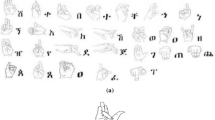Abstract
This work is to bring mobile-based sign language recognition system into real time. Selfie sign videos are captured with smartphone front camera. Morphological gradients along with Sobel edge operators are used to extract hand contour from each sign video frame. Discrete cosine transform (DCT) of hand contour is optimized by principle component analysis (PCA) to reduce the execution time. The four statistical features such as mean, skewness, standard deviation, and kurtosis are calculated for the optimized hand contour DCT. The feature vector formed with these four statistical features is used for sign classification using artificial neural networks (ANN) classifier. The performance of SSLRS is evaluated with the word matching score (WMS).
Access this chapter
Tax calculation will be finalised at checkout
Purchases are for personal use only
Similar content being viewed by others
References
Anantha Rao, G., & Kishore, P. V. V. (2016, October). Sign Language recognition system simulated for video captured with smart phone front camera. International Journal of Electrical and Computer Engineering (IJECE), 6(5), 2176–2187.
Kishore, P. V. V., & Rajesh Kumar, P. (2012). A video based Indian sign language recognition system (INSLR) using wavelet transform and fuzzy logic. In IACSIT international journal of engineering and technology (Vol. 4, No. 5, pp. 537–542).
Tanibata, N., Shimada, N., & Shirai, Y. (2002). Extraction of hand features for recognition of sign language words. In Proceedings of the international conference on vision interface.
Parul, H. (2014). Neural network based static sign gesture recognition system. International Journal of Innovative Research in Computer And Communication Engineering (Ijircce), 2(2), 3066–3072.
Rao, G. A., & Kishore, P. V. V. (2018). Selfie video based continuous Indian sign language recognition system. Ain Shams Engineering Journal, 9(4), 1929–1939.
Rao G. A., Syamala, K., & Divakar, T. V. S. (2020). Selfie sign language recognition with shape energy features and ANN classifier. International Journal of Science Technology and Research, 9(04), 1936–1939.
Tharwat, A., Gaber, T., Hassanien, A. E., Shahin, M. K., & Refaat, B. (2015). SIFT-based Arabic sign language recognition system. In Proceedings of the Afro-European conference for industrial advancement (pp. 359–370). Springer Cham.
Sulman, D. N., & Zuberi, S. (2000). Pakistan sign language—a synopsis. Pakistan, Jun 2000. [Online]. Available: www.academia.edu/2708088/
Lee, G. C., Yeh, F.-H., & Hsiao, Y.-H. (2016). Kinect-based Taiwanese sign- language recognition system. Multimedia Tools and Applications, 75(1), 261–279.
Holden, E.-J., Lee, G., & Owens, R. (2005). Australian sign language recognition. Machine Vision and Applications, 16(5), 312.
Zieren, J., & Kraiss, K.-F. (2005). Robust person-independent visual sign language recognition. In Iberian conference on pattern recognition and image analysis 2005 (pp. 335–355).
Maraqa, M., & Abu-Zaiter, R. (2008). Recognition of Arabic sign language (ArSL) using recurrent neural networks. In Proceedings of the 1st international conference on the applications of digital information and web technologies (ICADIWT), Aug 2008 (pp. 478–481).
Khan, N., Shahzada, A., Ata, S., Abid, A., Khan, Y., & ShoaibFarooq, M. (2014). A vision based approach for Pakistan sign language alphabets recognition. Pensee, 76(3), 274–285.
Ahmed, H., Gilani, S. O., Jamil, M., Ayaz, Y., & Shah, S. I. A. (2016). Monocular vision-based signer-independent Pakistani sign language recognition system using supervised learning. Indian Journal of Science and Technology, 9(25), 1–16.
Kausar, S., Javed, M. Y., & Sohail, S. (2008). Recognition of gestures in Pakistani sign language using fuzzy classifier. In Proceedings of the 8th conference on signal processing, computational geometry and artificial vision (pp. 101–105).
Anil Kumar, D., Kishore, P. V. V., Sastry, A. S. C. S., & Reddy Gurunatha Swamy, P. (2016). Selfie continuous sign language recognition using neural network. In 2016 IEEE annual India conference (INDICON).
Author information
Authors and Affiliations
Corresponding author
Editor information
Editors and Affiliations
Rights and permissions
Copyright information
© 2023 The Author(s), under exclusive license to Springer Nature Singapore Pte Ltd.
About this paper
Cite this paper
Rao, G.A., Syamala, K., Divakar, T.V.S. (2023). Mobile-Based Selfie Sign Language Recognition System (SSLRS) Using Statistical Features and ANN Classifier. In: Rao, B.N.K., Balasubramanian, R., Wang, SJ., Nayak, R. (eds) Intelligent Computing and Applications. Smart Innovation, Systems and Technologies, vol 315. Springer, Singapore. https://doi.org/10.1007/978-981-19-4162-7_34
Download citation
DOI: https://doi.org/10.1007/978-981-19-4162-7_34
Published:
Publisher Name: Springer, Singapore
Print ISBN: 978-981-19-4161-0
Online ISBN: 978-981-19-4162-7
eBook Packages: Intelligent Technologies and RoboticsIntelligent Technologies and Robotics (R0)




